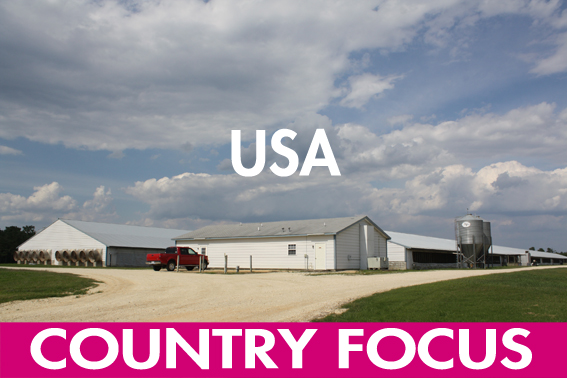What if the US pig sector embraced its potential?

The US pig industry is already huge, but what if the country embraced its potential? With better biosecurity, having an eye for market needs and acknowledgement of the exchange rate, the end of growth is nowhere near.
The United States is one of the top three producers and exporters of pigmeat in the world (the EU and China being the other two producers and the EU and Canada being the other large exporters) and, therefore, its influence on the global market is significant. But sometimes it has appeared that the average American hog farmer has not realised this. Indeed, even less than ten years ago many large US packers and processors may not have understood it. The world’s number one superpower has, perhaps, only just begun to see its impact on and it’s potential to affect the global pork market.
In the USDA’s 2012 census (the next census is 2017), the US hog and pig industry had sales of $22.5 billion, accounting for 6% of total US sales from agriculture. Farms specialising in hog production, i.e. farms with more than 50% of their income coming from hog and pig farming, were in decline, going from 30,546 farms in 2007 to 21,687 farms in 2012.
US total pigs breeding herd 1999 – December 2015
Distribution of hog farming in USA
When looking at the distribution of hog farming in the USA it’s apparent that two thirds of the hogs are found in just five states: Iowa, North Carolina, Minnesota, Illinois and Indiana. Another five states take that proportion up to almost 90%. This geographic concentration is matched by an increasing size and specialisation of breeding and fattening units. Almost half of all the hogs kept on farms are in herds that are greater than 5,000 head – most often under direct contract to a processor. Hence, about 50% of all hogs are owned directly or contracted to corporate processors in integrated operations. Consolidation of packers has been happening at a pace with the Chinese-based WH Group (Smithfield) and JBS produce now reported to be responsible for the production and sale of around half of the USA’s pigmeat.
Latterly, new investment in slaughter facilities has been occurring with Seaboard Triumph Foods building a new pork plant in Iowa. Most of the farmer owners of Triumph Foods, with around 445,500 sows, have been expanding in 2015. Separately, the Clemens Food Group is investing in a new, fresh pork processing facility in Michigan. The Clemens and the Seaboard Triumph plants will each kill about 10,000 hogs a day. The 2014/15 period has been a boom time for hog farmers and, in 2014, for pork exports.
Three features of US hog sector
Three features of the USA’s hog sector are worthy of note here. First, it has, until recently, been a relatively inward-looking industry with a ‘Frank Sinatra’ approach (doing it my way) to production methods, customer needs and export markets. That is changing and, under pressure from domestic retailers and foodservice operators and from overseas customers, US packers and hog farmers are now more inclined to consider setting up supply chains with welfare friendly practices, hormone-free production, and export oriented product lines. It’s now no longer a case of ‘doing it my way’ and the CEO of the US meat exporters’ federation talks openly about, ‘walking in the customer’s shoes’.
On the farm, productivity has been growing, as measured by the improvement in litter rates, and the importance of export markets to the final carcass value has been recognised. Crucially, US costs of production are still relatively low with cheap corn and proteins available to most hog farms. Truly, the US colossus is awakening to the potential of pigmeat sales at home and abroad.
Significance of macroeconomics
Secondly, the significance of macroeconomics and the dollar exchange rate has been tacitly acknowledged by US packers and the industry’s leadership in the last five years. The USA’s performance in export markets is affected by the relative strength of its economy and this implies that US packers and farmers have to produce pigmeat products that exactly fit the specifications of overseas buyers if price isn’t to be the sole determinant of a successful deal. Exports are no longer seen as ‘accidental’ and they are a target in themselves.
These lessons about the effect of exchange rates and quality control have, perhaps, been absorbed more readily because of the export successes of the USA’s neighbours. Canadian exporters had learnt these lessons in the decade after the millennium and their export efforts were, at that time, distinct and more effective than those of US packers.
Biosecurity
Finally, the potential for disease and poor biosecurity to have an impact on the US industry has been underlined very recently through the spread of the Porcine Epidemic Diarrhoea virus (PEDv) in the period since late 2013. The reduction in market hog inventories and incidence of record high US hog prices in 2014/15 have had consequences on hog numbers and pork supplies which are still being played out in 2016.
PEDv’s impact on mortality rates for very young piglets was seen in the quarterly litter rates collected by the United States Department of Agriculture (USDA) from PEDv and interrupted the trend line for the US hog sector’s productivity growth but the industry now seems to have recovered. 2016 looks like it will be a year of low prices and low or negative margins as the increased level of pigmeat supplies caused by previous high hog prices comes to market. Biosecurity is now a ‘must-have’ for large hog units in the USA.
Where next for the US hog industry? Well, it seems that key players in the sector have realised that a solid share of the global pigmeat market is there for the asking. Notwithstanding the recent volatility of the US market caused by PEDv and the US dollar’s strength there can be little doubt that US pork is competitive – and that the supply chain that lies behind US-produced pigmeat is more likely to expand than contract.
Certainly, it will become more sophisticated and move higher up the value chain. Watch this space.
| United States With 9.2 million km2 and the majority of the 320 million soul population at the coastlines, the United States inlands and are relatively thinly populated. Of these areas, predominantly the Mid West offers ideal conditions for agricultural activity. On vast plains, crops are grown and animals are reared. Late 2015, the US pig inventory was 68.2 million, with sow numbers exceeding 6 million. Pig numbers had not been this high since 2007, indicating that the effects of Porcine Epidemic Diarrhoea (PED) have been overcome. The US are the world’s largest pork exporting nation. Top destinations in 2015 were Mexico, Japan and Canada. |












